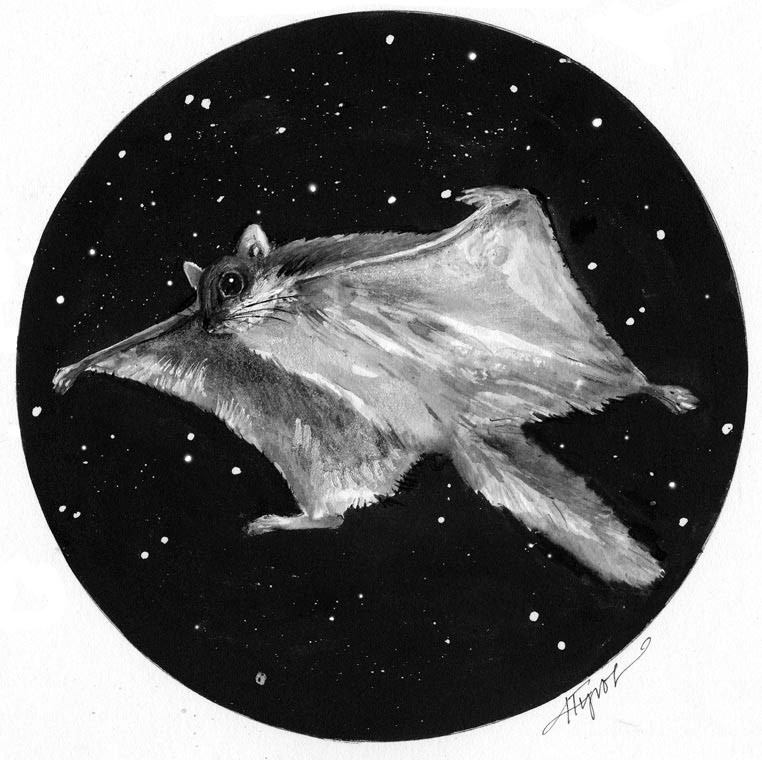
The calls come in all winter, said Paul DeBow of DeBow Wildlife Service in Plymouth, New Hampshire. If there is no snow, the peak will be in January or February, when it’s the coldest. Some people think the animals they hear partying in the attic are chipmunks, he says. Chipmunks in the attic in the middle of winter. But they are not.
Chipmunks, DeBow explained, hibernate in winter and what homeowners are probably hearing are flying squirrels. Because flying squirrels are nocturnal, few people ever see them.
There are two species of flying squirrels in our area, the northern flying squirrel and the southern flying squirrel. John Litvaitis, professor of wildlife ecology at the University of New Hampshire, said that the southern flying squirrel is the smaller of the two, often weighing just two or three ounces. “The northern flying squirrel [at three to five ounces] may be half again or may be twice as big as the southern,” he said.
But even the northern flying squirrel is smaller than a red squirrel. The southern flying squirrel is about the size of, yes, a chipmunk (which is a ground squirrel). Both species of flying squirrels can be distinguished from other squirrels by their patagium, the membrane between their front and rear legs that allows them to glide (not fly).
For all their similarities, the northern and southern flying squirrels are in a conflict that sounds a lot like war. “There was one paper that was titled something like, ‘The South Advances, While the North Retreats,” said Carolyn G. Mahan, professor of biology and environmental studies at Pennsylvania State University, Altoona, and a squirrel researcher.
Northern flying squirrels are creatures of conifer (cone-bearing tree) forests. “We know that northern flying squirrels depend on fungi that are associated with conifer forests,” she said. But southern flying squirrels can live anywhere. When conifers are cleared from a mountainside and homes are built, southern flying squirrels are happy to move in, bringing several more threats to the northerns. It’s not that the two species don’t get along; it’s that they get along too well. Squirrels of both species will pile into the same tree cavity on a cold winter night. Hybrids between the northerns and southerns follow.
The southern flying squirrels carry an intestinal parasite, unknown in northern squirrels in places where there are no southern flying squirrels. Where the two species overlap, the parasite may be harming the northerns directly, or, as Mahan’s research shows, the parasite may be altering the northern squirrel’s internal ecosystem, allowing other, previously harmless parasites to join forces with the newly introduced parasite.
The northern flying squirrel is in serious decline in the higher elevation forests of Pennsylvania, Virginia, West Virginia, and North Carolina. It is a state-endangered species in Pennsylvania. The Carolina flying squirrel, a subspecies, is federally endangered.
As the many phone calls to DeBow Wildlife Services suggest, northern and southern flying squirrels seem to be doing just fine in New Hampshire and Vermont, although it would be hard to tell if the southerners were overtaking the northerners as they are in other places. That mystery is the only reason both northern and southern flying squirrels are “species of greatest conservation need” in Vermont’s 2005 Wildlife Action Plan.
Litvaitis did studies of flying squirrel habitat in the 1990s in New Hampshire. Southern flying squirrels are dominant along the seacoast and the southern 20 percent of the state, he said – basically anywhere you find acorns and hickory nuts. “As you get inland and northern, it flips to northerns,” he said. He assumes the pattern is similar in Vermont.
One of the more recent studies on flying squirrels done by Litvaitis’ students focused on the animal’s energy use. That patagium, or gliding membrane, exposes a lot of a flying squirrel to the elements. “Once the temperature got below freezing, they buddy up,” he said, for warmth. “There are real benefits.”
That buddying up can mean up to 50 flying squirrels in your attic during the winter, explained DeBow. “You can’t trap them out,” he said. “It’s like bailing a leaky boat.” Instead, he uses exclusion, using either a one-way door or a cone that discourages them from re-entering.
These are the same tools DeBow uses for bats, but when it comes to control, he likes flying squirrels better for a few reasons. One is because, unlike the region’s disease-decimated bats, flying squirrels seem to be thriving, at least in the region’s attics. He thinks the popularity of improperly screened ridge vents may be one reason.
The other reason is that they are so boisterous and noisy. DeBow never has to guess when he’s gotten the last flying squirrel to leave the party.


Discussion *